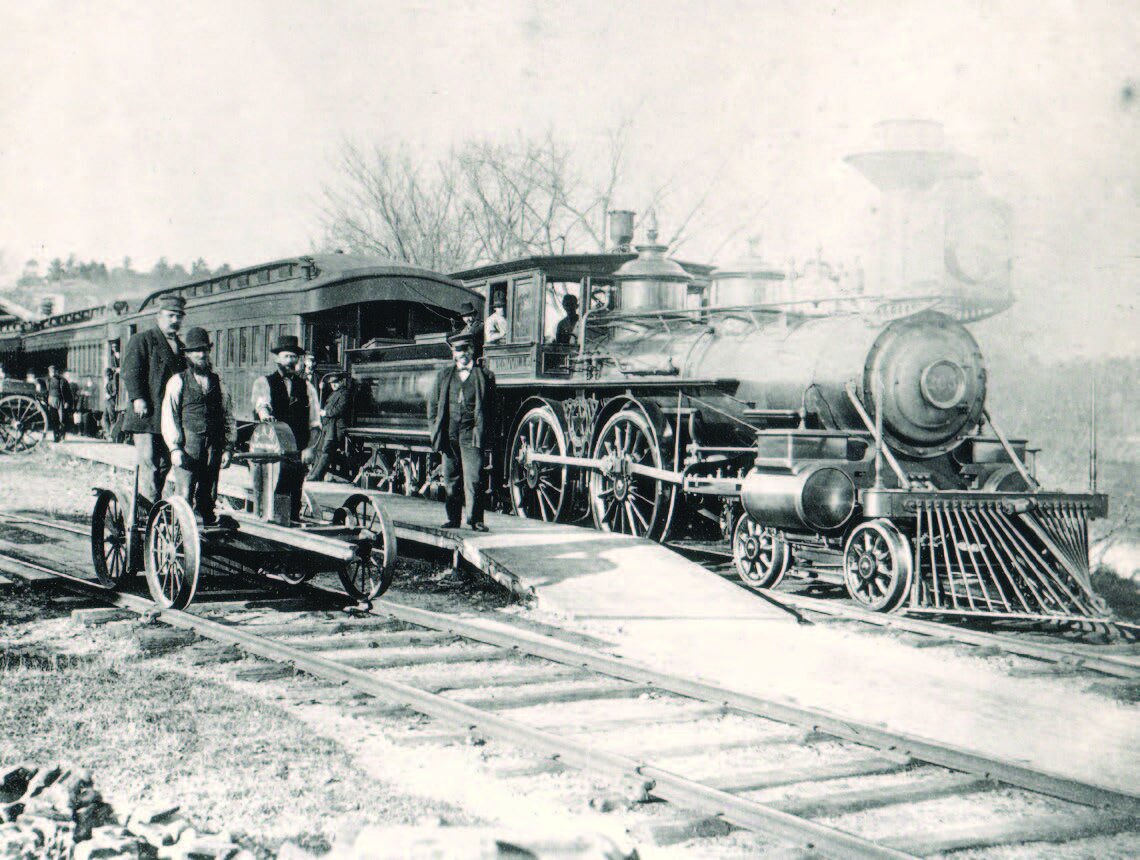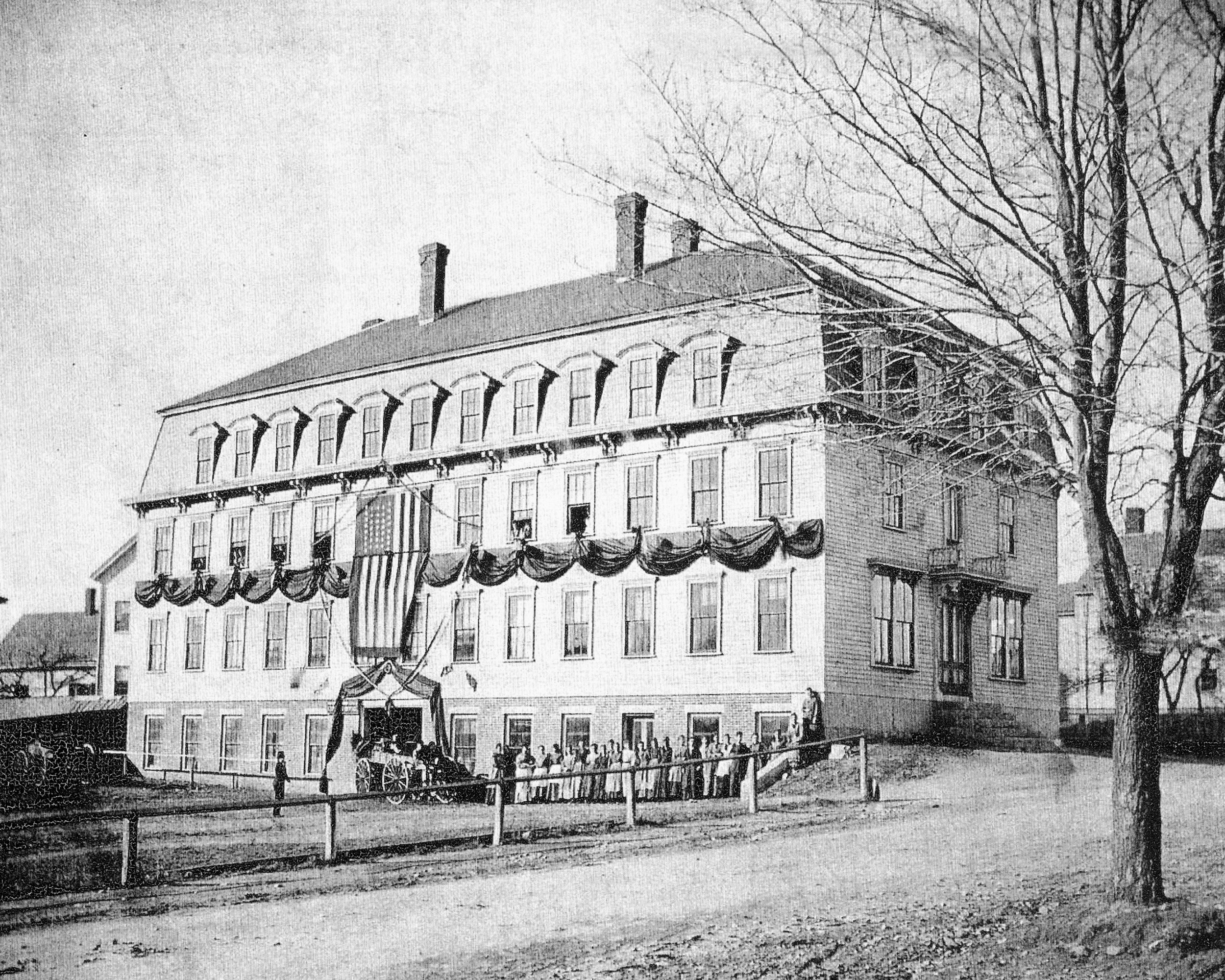
The Saxonville Railroad opened on July 6, 1846 and brought many changes to Natick’s economy and culture.
In Search of the Saxonville Railroad
This article was originally published in the Friends of Saxonville Fall 2021 newsletter.
Today, the Cochituate Rail Trail is the most visible vestige of Saxonville’s 120-plus years as a “railroad village.” The CRT follows the right-of-way of a rail line that connected Saxonville to Natick Center from 1846 to 1973.
There is little remaining evidence of the railroad in Saxonville. An abutment from a railroad bridge that carried trains over the Sudbury River to the mills is still in place by the bridge near the floodgates on Concord Street.
The Birth of the Saxonville Railroad
Locomotive at Saxonville Station, circa 1880’s, with “Saxonville” on the engine below the engineer. Courtesy of the Framingham History Center.
On July 6, 1846, the Saxonville Branch of the Boston & Worcester Railroad began operations twelve years after the B&W tracks were laid through Natick. The four-mile branch line extended from Natick Center to provide passenger and freight services to the woolens mills at the Saxonville Falls of the Sudbury River.
The benefits of a rail spur for the Saxonville mills were readily apparent. The mills needed raw materials for production and a way to get finished goods to market. Saxonville was a company town; many residents worked at the Saxon Factory Company and its successors. In 1845, the “inhabitants of Saxonville” petitioned the Massachusetts legislature for a branch connecting their village to the Fitchburg Rail line at Weston, ten miles away.
What persuaded the Boston & Worcester Railroad to build the line? Seeing the advantage this proposal might give a competitor, representatives of the B&W appeared before the Legislature to oppose the bill, noting that Saxonville was much closer to their line in Natick. In their 1845 report to stockholders, the Directors of the Boston & Worcester noted that they had “deemed it their duty to appear before the Legislature and oppose this grant,” which was “not demanded by any public exigency or any just claim.”
While the legislation was pending, the Directors voted to establish a branch in Saxonville within a year and announced that they had begun to survey the route. In their report to stockholders the following year, they noted that “the railroad was laid out... on an advantageous route, leading… from the station in Natick to the center of the village of Saxonville. The route crosses… Long Pond, at a point where it is narrow, by a stone arch.”
All Aboard for the Cochituate Aqueduct Groundbreaking!
On August 20, 1846, just six weeks after the branch opened, the Boston & Worcester ran a special train on the line with a VIP passenger list. The train stopped near the tracks crossing Commonwealth Road (now Route 30). The dignitaries, who included Boston Mayor Josiah Quincy, Jr., and his cousin, former US President John Quincy Adams, came to break ground for a new Cochituate Aqueduct on the east side of Long Pond, and, as part of the ceremony, Long Pond’s name was changed to Lake Cochituate. The gravity-fed aqueduct, completed in 1848, provided Boston with a new water source, connecting the lake to Boston via the Brookline Reservoir.
The completion of the Saxonville line just in time for its role in delivering the dignitaries to the groundbreaking was unlikely to have been a coincidence. One of the three water commissioners the Boston City Council appointed in May 1846 was Nathan Hale, a Boston & Worcester Railroad board director and nephew and namesake of the Revolutionary War hero.
The Branch’s Growth and Decline
Saxonville Railroad Station (School Street to the left), looking south. Courtesy of Susan Silva.
The passenger terminus at Saxonville was at a depot opposite Athenaeum Hall, with two sidings serving the mills. One siding crossed Concord Street and ran into the freight house (Building #7), the only building in the mill complex to survive the fire of 1883 and which still stands today. The second siding was closer to the depot and serviced the coal yard.
The Boston & Worcester merged with the Western Railroad in 1867 to form the Boston & Albany. Late 19th-century maps show stations at Felchville, Natick, and Commonwealth Road, Cochituate. Though these appear to have been flag stops, station structures were rudimentary.
Passenger service on the line, which rarely offered more than three trains daily, continued for 90 years, ending on February 15, 1936. The Saxonville passenger station was closed and later demolished. Freight trains continued the run to Saxonville for another 37 years until the Roxbury Carpet Company, the last firm to run the mills in Saxonville, moved its operations out of Massachusetts in 1973, ending more than 150 years of continuous textile manufacturing on the site. The Saxonville Branch continued to serve other freight customers in Natick until 2006.
“Relic of past uncovered in Framingham.”
On August 30, 1979, a story in Middlesex News under this headline described how contractors building Saxonville Village apartments on Concord Street were surprised to discover a six-foot thick, 70-foot wide circular slab of concrete on the site. It was the foundation of the roundhouse from the old Saxonville railroad station. The roundhouse was a turntable on which inbound railroad locomotives arriving at the dead end of the branch line were turned around for their trip back to Natick.
The Roundhouse had been abandoned before World War II and lost to memory, and the slab had to go if the apartments were to be built. The developers brought in extra workers and special equipment to demolish it so the apartments’ foundations could be laid. A few days later, nothing was left but a heap of concrete rubble, reportedly dumped in the Saxonville Dam on Fenwick Street to help control dangerous swirling eddies at the dam.
The News story closes with the following postscript: “One backhoe worker got something extra for his efforts – he found a 1920 silver dollar in the wreckage.”
By: Terri Evans
Terri Evans serves on the Natick planning board and the board of the Natick Historical Society, where she worked on a series of historical panels for the Natick section of the Cochituate Rail Trail. She shares stories of Boston’s architectural history as a guide with Boston By Foot and is a long-standing volunteer with the Friends of the Morse Institute Library in Natick.


